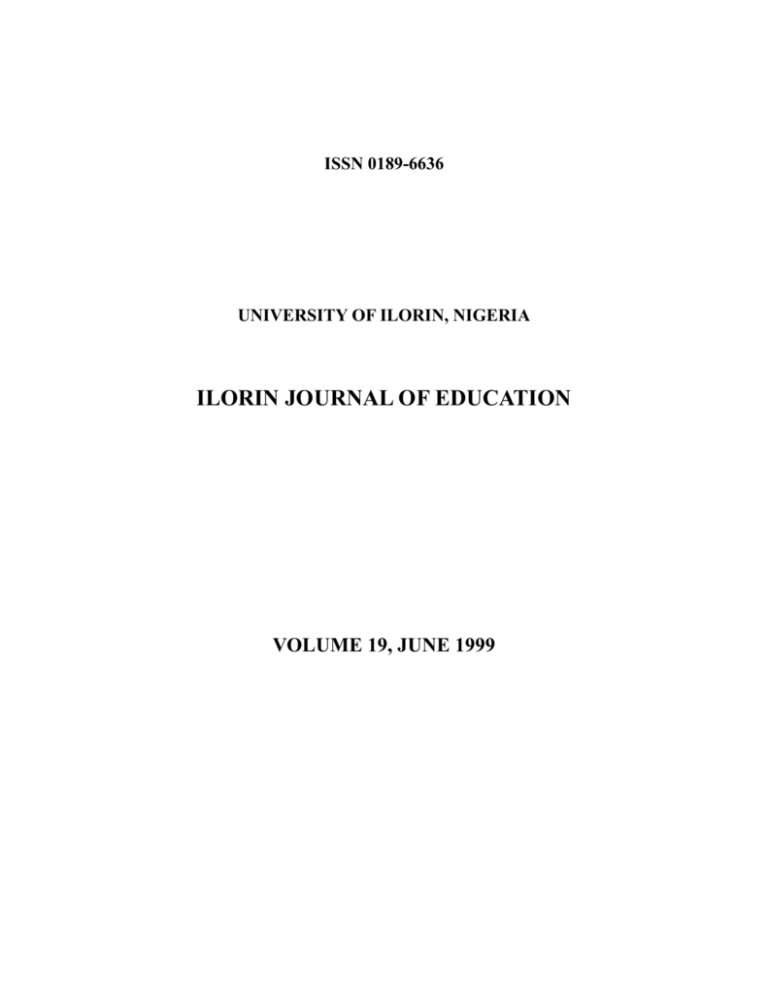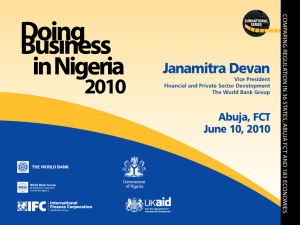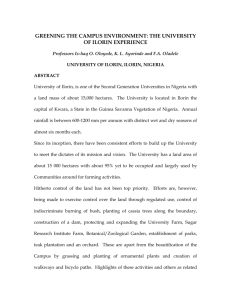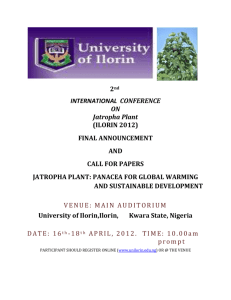ISSN 0189-6636 - University of Ilorin
advertisement

ISSN 0189-6636
UNIVERSITY OF ILORIN, NIGERIA
ILORIN JOURNAL OF EDUCATION
VOLUME 19, JUNE 1999
CONTENTS
Title Page
Copyright page
Notes to Contributors
Editorial Board
Contents
i
ii
iii
iv
v
(Mrs.) Y. Ijaiya (Ph.D.) - Effects of Over-Crowded Classrooms on
Teacher-Students Interactions.
1
O. R. Fabayo (Ph.D.) - Evaluating the Impact of Teaching Practice in
the Nigerian School System.
12
A. Oseni - The Continuous Assessment Policy: English Language
Teachers' Preparedness.
19
L. T. Ajibade and U.A. Raheem - A Reappraisal of Fieldwork as a
Teaching Method in Geography.
27
O. A. Idowu - Regional Variations in English in Nigeria and the
Implications for its Teaching as a Second Language.
36
B.O. Ibrahim - A Study of Factors Influencing Choice of History
in Kwara State Secondary Schools.
42
K.O. Omoiawon - The Role Physical Education in the Promotion
of Health and Well-Being.
51
S. O. Medahunsi (Ph.D.) - Judgments of Reading Levels: Are
Teachers Always Right?
Timothy O. Oyetunde and Chinwe A. Muodumogu - Parents'
Involvement in their Children's Literacy Development: Findings
and Implications for Building Effective Home-School
Partnerships.
v
55
64
Apegba Ker, (Ph.D.) - Problems of the Book Industry and
Educational Development in Nigeria: Lessons for the 21st Century.
70
D.O.K Omole (Ph.D.) & Mr. S.O. Ajayi - A Correlation Study of
Basic Science Subjects' Scores in Theory and Practical of Kwara State
College of Education.
75
A. O. Abolade (Ph.D.) - Computer Literacy in Secretarial Practice in
Nigeria: A Dipstick Paper.
81
T. O. A. Babafemi - An Assessment of the Implication of the 6-3-3-4
System of Education in" Nigeria: A Case Study of Ilorin, Kwara
State.
84
Mr. Y. Y. Muslimi - Implementing the Mother Tongue-Medium Policy
in the Lower Primary Classes: A Case Study of Selected Primary
Schools in Saki-West Local Government Area of Oyo State, Nigeria. 94
Sule Abdulrahaman Ozovehe (Ph.D.) - A Critical Analysis of the
Primary School Mathematics Teacher Educational Objectives in
Nigeria.
100
Ogunlade, P. O. (Ph.D.) - Socio-cultural and Political Determinants
of Educational Growth in the Lokoja Confluence Axis of Nigeria
(1865 - 1920): Lesson for the Present -Day Nigerian Educational
System.
107
L. A. Yahaya (Ph.D.) - Gender Differences, Behaviour Patterns and
Job Performance of Federal Civil Servants in Nigeria.
120
Usman, A. Saliu - The Development and Roles of Public Libraries
in Nigeria.
129
Mudashiru Olalere Yusuf - A Conceptual Framework for the
Establishment of an Open University in Nigeria.
136
vi
Ilorin Journal of Education Volume 19, June 1999
EFFECTS OF OVER-CROWDED CLASSROOMS ON
TEACHER-STUDENT INTERACTIONS.
By
Yetunde Ijaiya
Department of Educational Management, University of Ilorin, Ilorin.
Abstract
The study was carried out to find out the most serious effects of overcrowded classroom on teacher-student interactions and the frequently used coping
strategies adopted by the teachers. Using Spearman rho correlation coefficient, a
weak positive correlation was found between the opinion of teachers and students
on the most serious effects of over-crowded classroom, while a moderate positive
correlation was found in their opinions on the coping strategies. Both sides however
considered rampant noise making as the most serious problem. Findings showed
that over crowdedness diminishes the quantity and quality of teaching and learning
with serious implications for attainment of educational goals. To solve this problem,
it is suggested that both the federal and state Government make the building of
additional classrooms and provision of students' furniture a priority in their
educational planning at all levels.
Introduction
Since Western education became firmly rooted in Nigeria, it has faced
myriads of problems. Most of these problems are hardly lost on the various
governments, whether during colonial or post-independence era. It has resulted in
the setting up of various commissions (e.g. the Ashby Commission of 1960; the
1969 curriculum conference, etc) to examine Nigeria's educational problems and
make recommendations. These problems pertained to the quantity and quality of
teachers, educational facilities, curriculum planning and development, etc.
Adaralegbe (1983:16) noted that "a recurring feature in Nigerian secondary school
system from its inception about 120 years ago was its poor staffing". Adesina
(1990:76) speaking on the physical facilities also observed "Post-independence
Nigeria saw most Nigeria's primary and secondary school buildings no better than
they were during the colonial era". In fact, most of them are worse now having
suffered from lack of maintenance and weather conditions (e.g. rain-storm). Though
the various Governments, military and civilian, have given considerable attention to
the provision of more teachers and schools, the reality in most schools today, from
the primary to the tertiary levels, confirms that the problems still linger.
The problems of shortage of teachers and classrooms are intricately
interwoven and when both combine with large pupil enrolment, the consequence is
over-crowded classrooms. This is the sad truth in many Nigerian classrooms
especially in the major towns and cities with many classes registering fifty (50) to
1
Ilorin Journal of Education Volume 19, June 1999
Yetunde Ijaiya
one hundred (100) students and above which is clearly above the internationally
recommended standard (See Table 1).
The poor state of the physical facilities in the schools confirms Adesina's
(1990 p.76) observation that this aspect of the educational problem has been
consistently ignored in educational "plans and reports". He cited the 'example of
Banjo Commission (1961) in the then Western Nigeria and a similar One in the old
Eastern Nigeria which failed to mention 'inadequate physical facilities' as one of the
fifteen factors considered responsible for failing standard of education. Only the Old
man Report on Northern Nigeria gave some attention to buildings and furniture in
schools (Adesina, 1990). The consequence as noted by the West Africa study group
of the Nuffied Foundation (1952) in their report on educational policy and practice
in Tropical Africa is that "... most of the school buildings are poor and made worse
by over-crowding..." (Adesina, 1990 p.70).
Ordinarily, the phenomenon of rural-urban drift in an emergent nation like
Nigeria normally exerts pressure on the facilities and services such as hospitals,
schools, transportation etc. However, the introduction of the Universal Free Primary
Education (U.P.E.) first in the old Western Region in 1955 and later in the Eastern
Region in 1957 as well as the launching of the U.P.E. Scheme by the Federal
Government in 1976 compounded the problems of providing adequate facilities in
schools to meet the resultant unprecedented upsurge in pupil enrollment (Akinyemi,
1983). With inadequate planning for the expected population explosion in schools,
over crowded classrooms now become a permanent feature of academic setting at
all levels of thee educational system.
In addition, Educational planning in Nigeria has always been thought of in
terms of quantitative growth, which is usually above the financial capacity of the
Government (Adesina, 1990). A recent example is the implementation of the current
6-3-3-4 system of education, which is seriously affected by lack of adequate
funding and poor preparation. Even though the Federal and State Governments have
shown serious commitment to educational development through their annual
budgetary allocation to Education in recent years (allocation to Education sector is
second only to Defense), the attention given to physical facilities is far from being
adequate. The issue at stake is not how 'huge' the allocation is but how 'adequate'. In
a study by Ndagi (1983) on educational financing under military rule (1968-1978) it
was found that:
of the financial resources allocated to secondary level institutions, over
80% -went to the personal emolument of staff and the maintenance of
students while less than 10% went to the purchase of educational
materials and equipment, (p. 195).
And in the case of the State Governments, the same study found out that.
of the resource allocated to secondary level education, on average, over
2
Ilorin Journal of Education Volume 19, June 1999
Yetunde Ijaiya
50% went to the personal emoluments of Staff and over 30% to the
maintenance Of students while less than 15% was Used for the purchase
of educational Materials and equipment; (pp. 195-196).
In the case of students' furniture, some state Governments have completely
handed off the supply. Students either pay to the school to purchase for them or they
bring from home. The latter is more popular. Such furniture now come in all shapes
and sizes presenting an ugly sight in the classroom.
The phenomenon of overcrowded classroom as well as poor quality and
inadequate furniture in the classroom due to unlimited expansion has taken its toll
on the educational system. Only few people will deny that the quality of teaching
and learning is on the decline at all levels of the educational system. The poor result
of the Senior Secondary School examination (SSCE) in almost all subjects in recent
years is one potent indicator. The increase in examination malpractices cannot be
divorced from poor seating arrangement in classrooms. The quantity and quality of
interaction in the class are likely to be adversely affected due to lack of space for
moving round the class and the over whelming number of students that the teacher
has to deal with within a forty-minute lesson. Nolasco and Arthur (1988) also
identified five likely problems of large classes:
coping with the noise, persuading the class to use English, managing the
introduction and setting up of activities, making limited resources go a
long way and monitoring the work of individuals within the class (p.5).
These and many other problems inform the decision to conduct this study
with the hope that it will help to draw more attention to this ugly situation under
which learning is expected to take place and educational objectives are to be
attained.
The Problem
The classroom is the heart of any educational system. No curriculum
planning is complete without implementation and evolution, both of which are
mainly carried out in the classroom. Most of the class activities take place while
students are seated. The seating arrangement is therefore too important to suffer the
kind of neglect being experienced by many secondary schools in the country. As
rightly observed by Cohen and Manion (1983 p.221) "a careful attention to seating
arrangement contributes as effectively as any other aspect of classroom
management and control to overall success with a class subsequently". Adesina
(1990 p.13) also affirms that one potent index for evaluating educational standards
and quality is an examination of the physical facilities available for learning
experiences".
3
Ilorin Journal of Education Volume 19, June 1999
Yetunde Ijaiya
The seating arrangement can make or mar any lesson. Ideally, in a
secondary school, especially in a mixed ability grouping, as found in Nigeria
schools, seats should be arranged in rows with a reasonable amount of space
between them to allow for proper teacher-student and student-student interactions as
well as allow for individual and group work (Cohen and Manion, 1983). To this
end, the ratio of teacher to students should not exceed 1:30 or at most 40 judging by
the size of the classrooms. But what one finds in many o these classes is between
ratio 1: 50 and 1: 150 in certain cases.
This study was therefore interested in identifying the major problems
caused by over-populated classes in Nigeria growing towns and cities with a view to
making suggestions that could help to alleviate the problems.
The Research Questions
The study addressed the following questions:
1.
2.
Is there any correlation between the ranking of teachers and students with
regard to the effects of over-crowded classrooms on classrooms
interactions'?
Is there any correlation between the ranking of teachers and students
concerning the coping strategies adopted by teachers in over-crowded
classroom?
Methodology
The sample used in this study consisted of teachers and students from
secondary schools in Ilorin metropolis. Ilorin is considered a typical example of the
growing cities In Nigeria, which has been feeling the pinch of population explosion
in schools. Using simple random sampling technique, eight schools were selected
out of thirty secondary schools in the township. A total of 250 students randomly
selected were served a researcher-designed questionnaire though their teachers out
of which 206 were found usable. The teachers' sample consisted of 141 teachers
also randomly selected from the eight schools. The total sample was three hundred
and forty seven (347).
The Instrument
Two types of instrument were used. One involved the use of class registers
to obtain pupil enrolment by classroom J.S.S. 1 to S.S.S. 1. It was assumed that
most SS 1 students would eventually make it to SS 3. The schools are indicated by
letters A to H (Table 1). The second instrument was a questionnaire made by the
researcher to determine the most serious effect of over-crowded classroom on
Teacher - student interactions. It consisted of two sections. Section A consisted of
4
Ilorin Journal of Education Volume 19, June 1999
Yetunde Ijaiya
thirteen (13) statements which the respondents had to rank in descending order
according to their view of their seriousness on classroom interactions. Section B
presented seven (7) coping strategies which could be adopted by the teacher to
combat the problems of over-crowdedness in the class. Respondents were required
to identify the ones commonly used by their teachers. The questionnaire was
validated by experts in Educational Management. The reliability co-efficient of the
questionnaire was 0.85. The data was analyzed by sing Spearman's rho correlation
coefficient.
Table 1: Class-by-class Enrolment of some Secondary Schools in Ilorin Metropolis.
Schools
Class
JSS 1A
JSS IB
JSS 1C
JSS ID
JSS IE
JSS IF
JSS2A
JSS2B
JSS2C
JSS2D
JSS2E
JSS2F
JSS3A
JSS3B
JSS3C
JSS 3D
JSS3E
JSS3F
SSS 1A
SSS1B
SSS 1C
SSS ID
SSS IE
SSS IF
A
90
88
82
61
94
95
100
84
85
78
77
90
133
123
-
B
70
73
70
52
50
56
43
43
79
-
C
107
109
110
119
104
99
104
101
100
110
82
79
85
79
83
65
70
123
85
84
-
D
100
98
95
100
100
94
81
825
74
75
74
21
85
96
61
-
E
71
69
72
73
52
52
56
31
68
67
-
F
62
69
71
69
66
62
59
70
69
58
50
63
58
52
46
47
56
50
56
53
59
63
60
66
G
80
85
80
60
55
58
50
48
45
50
-
H
77
81
86
83
80
79
885
77
60
58
65
70
30
65
70
-
Source: Class Registers through the counseling Department of each school.
•
Note that all the classes are over-populated except SS 1A in school. D, E,
and H which are science classes.
Data Analysis and Results
Below is the analysis and results of the data collected in relation to the
research questions.
5
Ilorin Journal of Education Volume 19, June 1999
Yetunde Ijaiya
The first question sought to find out if there was any relationship between
the ranking of the teachers and students with regard to the problem of over-crowed
classroom. Table 2 below presents the analysis and result of the data collected.
Table 2: Result of Spearman’s Rho performed to compare the rankings of Teachers
and Students on the problems of over-crowed classroom and Teacher- Student
interactions.
S/
No
Items
1.
Noise-making
is very rampant
during lessons
Securing
students' total
attention during
lessons is almost
impossible
Many pupils at
the back do not
participate much in
the lesson.
Quiet students often
get neglected
Only brilliant
students answer
questions in class
Teachers questions
cannot spread
round the class
Teachers movement
is restricted to the
front of the class
because students'
lockers have blocked
every space
Teachers cannot
move round the
class to mark class
to mark students'
assignment.
It is impossible to
catch students
cheating.
Late-comers
sneak in unnoticed.
2
3.
4.
5.
6.
7.
8.
9.
10
No of
Ranking Students' Ranking
Teachers' by
Response by
response Teachers
students
d
d2
24
1
40
1
0
0
16
4
18
5
-1
1
17
3
10
8
-5
1
7
10
20
4
6
36
8
7
6
10
-3
9
7
8
30
3
5
25
22
2
2
13
11
121
12
5
3
12
7
49
2
13
35
2
11
121
6
9
5
11
-2
4
6
Ilorin Journal of Education Volume 19, June 1999
11.
12.
13.
It is difficult for
teachers to see
students who are not
paying attention.
5
Truants go unnoticed
in the class.
4
Teaching aids
cannot go round
everybody.
10
Yetunde Ijaiya
11
15
6
5
25
12
12
79
5
25
6
9
9
-3
9
Σd = 450
P = 1 - 6(450)
13(132 - 1)
P = 1 - 2700
2184
P = 1 - 1 .236
P = 0.236
The result in table 2 above showed a weak positive correlation (P = 0.236)
between the ranking of teachers and students. This result implied that both sides
shared a slight consensus on the problems associated with over crowded classroom.
Both teachers and the students ranked item 1 - " noise-making is very rampant
during lessons" as the most serious problem of over- crowed classroom. Other
rankings are not so similar. The teacher's other rankings showed item 7 - " teacher's
movement is restricted to the front of the class because students' lockers have
blocked every space" and item 3 - "many pupils at the back do not participate much
in the lesson" received second and third place respectively. Students on the other
hand, ranked item 9 - " it is impossible to catch students cheating" second (ranked
last by teachers) and item 6 - "teachers' questions cannot spread round the class due
to time limit", was ranked third, though ranked eighth by teachers. For the student
item 7, ranked second by the teachers, was the least of the problems and was ranked
last (thirteenth) by them. Other rankings are as shown in Table 2.
7
Ilorin Journal of Education Volume 19, June 1999
Yetunde Ijaiya
The second question desired to know if there was correlation between the
rankings of teachers in dealing with the problem of over-crowded classrooms. The
result is presented in Table 3 below.
Table 3: Result of Spearman's Rho performed to compare the Teachers' and
Students' Ranking of the Coping Strategies adopted by Teachers.
TEACHERS
STUDENTS
No of
Ranking Students' Ranking d
Teachers' by
Response by
Response Teachers
students
S/No
Items
a.
Standing in front of
the class all the time 48
Teacher raising his
or her voice
72
Dividing students
into groups for
lessons.
0
Re-arranging
students from time
to time so that those
at the back come to
the front for some
part of the term
12
Class assignments
are always collected
to be marked after the
lessons.
54
Punishment for
students who
disturb.
84
Sending disobedient
students off the class. 66
b.
c.
d.
e.
f
g.
P=1-
6(17.5)
7(72 - 1)
d2
5
144
25
2.5
6.25
2
134
4
-2
4
7
36
7
0
0
6
66
(}
0
0
4
102
5
-1
1
1
144
2.5
-1.5
2.25
3
156
1
2
.
P = 1 - 105
336
P = 1 - 0.313
P = 0.687
8
4
Σd2 = 17.5
Ilorin Journal of Education Volume 19, June 1999
Yetunde Ijaiya
As shown in Table 3, a moderate positive correlation (p=0.687) was found
between the ranking of both teachers and students with regard to the coping
strategies used by teachers, thus implying that both sides had a most similar view of
the frequently used teachers' coping strategies. According to the teachers, the most
frequently used coping strategies is "punishment for students who are disturbing".
This is followed by " teacher raising his or her voice" and "sending disobedient
student out of the class", both ranked second and third respectively. "Dividing
students into groups for lessons" was found to be unpopular as a coping strategy for
the problem of over-crowded classes. For the students, the most frequently used
strategy by teachers is "sending disobedient students out of the class". Table 3 also
showed that " standing in front of the class all the time", and "punishment for
students who are disturbing" received equal ranking from the students.
Discussion
The main objective of this study was to identify the major problem
associated with over-population of students in classrooms resulting in poor seating
arrangement as they affect teacher- student interactions in the class. The findings
showed that noise- making, difficulty of catching students, restriction of teacher's
movement to the front of the class and inadequate participation in the lesson by
students sitting at the back are the major problems caused by overcrowded classes.
Findings also showed that questions cannot spread much round the class. The
findings of this study revealed the trend or direction of concern for both the teachers
and the students. While both of them consider noise making as a number one
problem, the students were however more concerned with catching fellow students
who indulge in cheating during tests and examinations than do the teachers. This is
not strange since the students are expected to know each other better than the
teachers, being together most of the time. This, coupled with the teachers'
movement restricted to the front of the classroom, makes it difficult for the teachers
to catch those cheating. That teachers were also concerned about their movement
being restricted also showed that they were aware of the limitations that the seating
arrangement has forced on them. Both the teachers and student were however
concerned about lack of enough opportunity for students' participation in the lessons
due to the size of the class (See Table 1).
The pedagogical-cum-educational as well as management implications of
these findings cannot be over-emphasized. That both the teachers and students
identified noise- making as most serious problems of over-populated classroom is
significant. This confirms Nolasco and Arthur's (1988) observation that noise is a
major problem of large classes. Any experienced teacher would agree that very little
meaningful learning, if at all, could take place in a noisy environment. Noise
making implies that such students are not paying attention to the on going lesson.
Besides, noise making has been recognized as a barrier to effective communication
9
Ilorin Journal of Education Volume 19, June 1999
Yetunde Ijaiya
and effective teaching (Ogunsaju, 1990). The finding also indicated the level of
class control problems in such classes. This therefore raises serious questions about
the quality and quantity of teaching / learning in such classes.
Also, a close observation of classroom behavior shows that noisemakers
tend to concentrate at the back of the class. The finding that student s at the back do
not participate much in the lesson is therefore not surprising. This however calls for
better strategies or skills from the teachers to handle this section of the class more
constructively.
Questioning is an integral part of teaching. In fact, no teaching is complete
without evaluation. It is through evaluation that the teacher determines whether the
lesson objectives have been achieved or not. The finding that teachers' questions
cannot spread round the class seems to suggest that many students have no
opportunity to participate in the evaluation How then does the teacher identify their
strengths and weaknesses so as to assist them especially when the teachers rely so
much on oral evaluation for every lesson? All these have serious implications for
curriculum development and implementation.
Also, where teachers are glued to the Iron! of the classroom, ii becomes
near impossible to go round either to mark pupils" work or assist the individual
student. They are also forced into using the lecture method all the tune because of
the rigidity in the scaling arrangement
On the issue of coping strategies adopted by teachers, findings showed that
punishment is the most popular measure. The use of punishment over and above
other more positive strategies is not in the best interest of the students. Such
punishment sometimes turn to be negative reinforcement and acceptable to the
student. And though its use cannot be totally avoided, educationists would rather
recommend the use of positive reinforcement (Fontana, 1981). By using
punishment, teachers seem to have picked the most convenient way of getting out of
the problem of class control (for example, sending erring student out reduces the
number of student to cope with). More positive options like dividing students into
groups will likely make more demand on their energy and time, hence the
avoidance.
Conclusion and Suggestions
From the findings of this study, one can conclude that seating arrangement in over
populated classes places limitations on the quality and quantity of interactions
between the teachers and the students as well as on the quality of teaching and
learning. The findings also cast some doubt on the skills of the teachers in dealing
with the problems. Indulging in negative reinforcement like punishment is not
educationally expedient These are direct result of poor quality training of teachers.
10
Ilorin Journal of Education Volume 19, June 1999
Yetunde Ijaiya
In view of the above, the following suggestions are made. Shortages of
classrooms and teachers in secondary schools need to be treated as a national crisis
worthy of the attention of both the Federal and State Governments. A lasting
solution is therefore building of additional classrooms and employing more
teachers. In fact, judging by Table 1, there is a need to double the existing facilities.
A ratio of 1:35 teacher to student is hereby suggested. Federal and State
Government should lift embargo specifically on the employment of teachers. School
plant need read to be totally over-hauled.
On student' furniture, the Ministries of Education should direct school
managers to treat them like school uniform which is organized by each school in
order to ensure uniformity. In the alternative, the Government could design a
standard set (chair and desk) for students to buy from specified local furniture shops
at an affordable price.
On the coping skills of the teachers, a more positive approach as suggested
by Nolasco and Arthur (1988) is to establish some formality in class activities right
from the beginning of the lesson. This could be in form of class routines and
convention that would keep the students busy as soon as the lesson starts. Adequate
planning and implementation of lesson would also keep them busy throughout the
lesson. To this end, seminars and workshop should be organized for teachers to
sharpen their skills of teaching.
References
Adaralegbe, A. (1983) 'Secondary education in Nigeria'. In S. Adesina, H.
Akinyemi, and K. Ajayi, (Eds), Nigerian education trends and issues. Ilelfe University of Ife Press.
Akinyemi, K, (1983). Trends in development of primary education in Nigeria, in
Adesina, S,Akinyemi, K and Ajayi, K (Eds), Nigerian education trends and
issues. Ile-lfe. University of Ife Press.
Adesina, S. (1990) Educational management. Nigeria: Fourth Dimension.
Cohen, & Manion, L. (1983) A guide to teaching practice. London: Methuen.
Fontana, D,(1981) 'Class control and management'. In D. Fontana, (Ed.),
Psychology for teachers. London: The Macmillan Press.
Ndagi, J .0(1983). 'Financing of education in Nigeria under military rule {19681978V In S. Adesina. K. Akinyemi, & K. Ajayi, (Eds), Nigerian education
trends and issues. Ile-lfe: University of Ife Press.
Nolaso, R. &. Arthur, L.(1988) Large classes: London: Macmillan Publishers.
Ogunsaju. S. (1990) A guide to school effectiveness in Nigeria. Ibadan: Laville.
11










